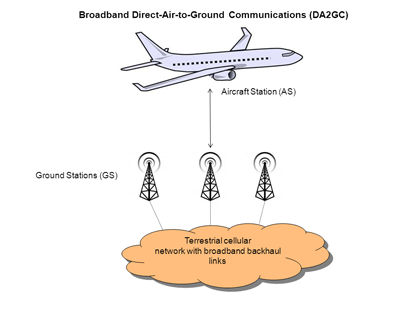Surfing the clouds: ECC works on Broadband Direct-Air-to-Ground Communications
Connectivity everywhere
Mobile customers expect to be connected everywhere, every time, with all kinds of mobile devices. This includes the provision of broadband services onboard aircraft and European airlines are very keen to offer internet services to their flight passengers as soon as possible, especially in their continental fleets.
Two ways to link up
The connection link between the aircraft and the ground can be established either via satellites or by means of Direct-Air-to-Ground Communications (DA2GC), in which the radio signal travels directly between the aircraft and the ground.
For future broadband services, it's likely that the service provision via satellite will be conducted by using Ka-Band satellite capacity and a considerable number of Ka-Band satellites have already been put into operation or are under procurement. Satellite operators also consider mobile platforms, such as aircraft and vessels, as a considerable part of the addressable market and the ECC is currently working on a new ECC Decision supporting Earth Stations on Mobile Platforms (ESOMP).
Alternatively, in North America, a DA2GC system has been established with more than 1500 commercial aircraft and 5000 business aircraft equipped so far. In addition, the Civil Aviation Administration of China (CAAC) is testing a DA2GC system.
The ECC is now conducting investigations with the aim to identify spectrum for broadband DA2GC services after having received two ETSI spectrum utilisation proposals for them. The proposal for Europe is however designed to offer more bandwidth than today's solution in North America and hence is expected to be future-proof against increasing capacity demand by passenger and airline related services.

Overall end-to-end system architecture for broadband DA2GC
The establishment of a pan-European regulatory environment for broadband DA2GC would provide ample benefits for the users - i.e. airline companies and flight passengers - in Europe:
- As an alternative to satellite service provision, which by fostering competition might lead to a lower cost for the airlines and for the flight passengers;
- The technical implementation of broadband DA2GC and also the stimulus of competition may lead to a provision of other services at improved cost structures - including non-safety-relevant administrative communication services. This benefit to end customers and airlines may encourage higher and earlier service take-up;
- A DA2GC system avoids the round trip signal delay that is unavoidable with using geostationary satellites and hence can avoid the inefficiency of pauses in conversation;
- The costs for aircraft installations and maintenance are a key issue for airline companies. The broadband DA2GC equipment can be installed overnight to a plane, clearly an advantage to airline operators. In particular with regard to the aircraft antenna, a terrestrial solution has a clear advantage compared to existing satellite usage, with their smaller size giving better aerodynamics - meaning a lower penalty for fuel consumption and CO2 emissions than with satellite antennas.
Rapid growth
A further motivation arises from the expected growth of air traffic. A forecast from Eurocontrol published in October 2011 estimates 11.5 million movements (under Instrument Flight Rules) in Europe in 2017. This is 21% more than in 2010.
About 66 % of the European air traffic consists of domestic or continental flights, i.e. the main part of the airline business. In general a strong increase in percentage of aircraft fleet equipped with internet connectivity solutions is expected during the next years. According to market research approximately 50% of the world's fleet will have been equipped with Wi-Fi connectivity by 2020.
What and how
A broadband DA2GC system enables various types of telecommunications services, such as internet access and mobile multimedia services. It aims to provide access to broadband communication services during flights on a Europe-wide basis. The request for spectrum is related to the broadband direct air-to-ground radio solution. The connection with the flight passengers' user terminals onboard aircraft is to be realised by fixed or Wi-Fi-based onboard connectivity network (sometimes already available) and/or via GSM on-board aircraft and in the future possibly also via UMTS and/or LTE.
High interest from European industry
European industry successfully tested high-speed broadband for in-flight services to passengers using a direct-air-to-ground communication system based on LTE in late 2011. Several European airlines have indicated their interest in DA2GC services to the ECC, and we are also in contact with the Association of European Airlines (AEA).
Thomas Weber
ECO Expert in Frequency Management
